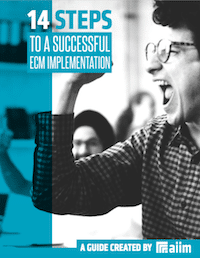The AIIM Blog
Keep your finger on the pulse of Intelligent Information Management with industry news, trends, and best practices.
Document Management | Enterprise Content Management (ECM) | Sharepoint and Office 365
Saving money is the most significant current driver. Compared to recent years, cost-saving has taken a clear lead over compliance as the primary business driver for investments in document and records management. Tracking the most significant business drivers over a number of years shows regulatory control and associated compliance risk peaking in 2007 with a fall back in the last two years to cost savings. This is obviously due to the economic downturn - which was in part caused by insufficient regulatory control. We feel that compliance and risk avoidance may rise again once the dust settles over the many regulatory lapses and forced mergers.
Share
Enterprise Content Management (ECM)
What is the core purpose or objective of your new Web presence? A new website can be all things to all people, so the first consideration when embarking on a project of this nature is to ask, what do you want to gain from your new website? This should influence your search for the Web Content Management solution of choice. For instance, if you are an online retailer, then using a WCM with a proven track record of this is vital. Do you need to integrate with 3rd party systems (ordering/billing/tracking) as part of that? Alternatively, if you are a public body or media agency, you could be delivering 1000s of pages of rapidly changing content with tight approval processes. Again, choosing a partner with a proven pedigree in delivering this scale is vital.
Share

Making an ECM implementation successful requires planning and attention to detail. The best way to create the right solution is to identify organizational goals and priorities. Learn how to manage a successful implementation in our free guide.
Change Management | Enterprise Content Management (ECM)
A consistent topic in ECM circles is low user adoption. We think of Enterprise Content Management (ECM) as “mature” technology; however, most companies still struggle with broad user adoption. In implementing ECM technology, we fundamentally change the way an individual or group does their job. Consequently, the business process and culture change associated with the technology is much more significant than the implementation of the technology itself.
Share
Enterprise Content Management (ECM)
Classification is key to realizing value from your content. Why is classification important? Anytime you want to do something more than blindly storing your unstructured content, you need to classify and organize it to help those tasks along. Better organized, classified information can be searched more effectively, archived, managed as records, or incorporated into business processes. There's a reason libraries classify and organize all those books.
Share
Compliance | Enterprise Content Management (ECM)
Regulations are complex and can’t be ignored. One of the challenges of being regulated is understanding exactly which regulations apply to your business. You may face “horizontal” reporting regulations, such as those contained in Sarbanes-Oxley that apply to all publicly-held companies. Or, you may be subject to vertical market-specific regulations such as HIPAA in health care or the FDA’s 21 CFR 11 rules. Or, you may face a raft of regulations from different governments and agencies. One thing is for sure; you can’t pretend these regulations don’t exist or hope they go away. Non-compliance may present a very real legal and financial risk to your organization.
Share
Enterprise Content Management (ECM)
Without commitment, there’s no point in moving forward. In my opinion, the single most critical element in building an Enterprise Content Management (ECM) strategy is commitment. I’m talking about the type of commitment you make when you jump out of a plane. Not that I’m suggesting ECM is like skydiving; if skydiving goes wrong, the pain doesn’t last. Commitment can’t be limited to a select few within the organization. For sure, the senior leadership team needs to demonstrate its commitment, but commitment needs to be present throughout the organization. Consider this: regardless of how committed the senior leadership team is, if the rank and file don’t buy in failure is guaranteed. So how do you get commitment? Find out what resonates and build from there. Is the motivator risk mitigation, environmental responsibility, competitive advantage, or access to information? The likely scenario is that the motivator changes depending on whom you’re talking to. Your job is to sell the program to your stakeholders on their terms, not yours.
Share